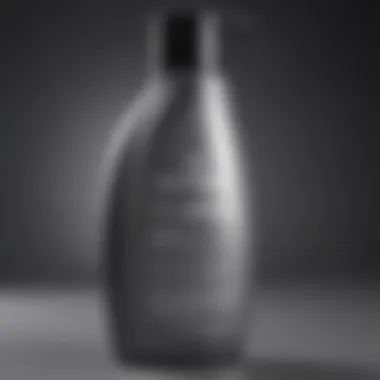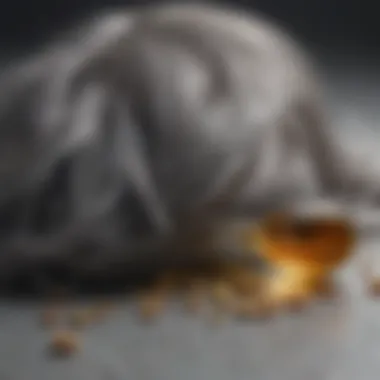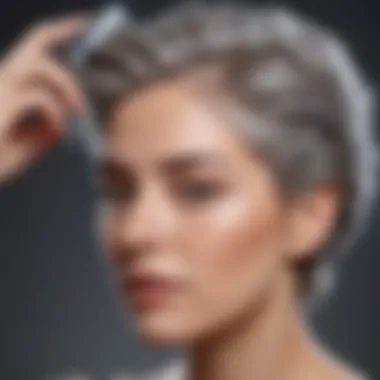Shampoo Solutions to Prevent Gray Hair Yellowing


Intro
Maintaining the beauty of gray hair can be quite the challenge, especially when that silvery hue starts to take on an unwelcome yellowish tint. This yellowing can arise from various factors, such as sun exposure, pollution, and even the products we use on our hair. But fear not; there’s a world of specially crafted shampoos designed to address these concerns. This article will take you step-by-step through the specifics of preventing yellowing in gray hair and help you choose the right product to preserve that stunning silver shade.
Gray hair needs a bit of TLC more than ever. Unlike our regular strands, gray hair is often coarser and drier. Therefore, using a shampoo that's formulated for gray hair not only combats yellowing but also hydrates and enhances the natural brightness of your locks.
In the sections that follow, we’ll break down the reasons why gray hair turns yellow, what ingredients you should seek out, and how to apply these products effectively. Plus, we’ll touch upon complementary hair care practices that’ll leave you with vibrant, healthy gray hair you can be proud of.
Stay tuned as we unravel the mysteries of gray hair treatment one thread at a time.
Understanding Gray Hair
Understanding gray hair is crucial in the quest for keeping it vibrant and lively. Gray hair signals an important transition not just in one’s appearance but also in how our hair reacts to various factors in our environment. The aging process, hormonal changes, and even lifestyle choices can impact the quality and color of gray hair. Therefore, knowing what happens to our hair as it turns gray provides context for selecting the right hair care products, especially shampoos designed to prevent yellowing.
Why focus on gray hair? Many people believe that gray locks signify a loss of youth, yet this stage can be embraced with the right care. For instance, understanding the specific needs of gray hair, which may differ from colored or naturally dark hair, is paramount. Gray hair tends to be coarser and may lose pigment altogether, leading to not just color changes but also texture issues. Therefore, appropriate preparation and care play a significant role in ensuring that gray hair remains healthy and stylish.
Transition to Gray Hair
When you start noticing those first glimmers of gray, it's often a mix of curiosity and contemplation. What does it mean? Am I getting old? In reality, transitioning to gray hair is less about aging and more about the natural progression of our bodies. As melanin production decreases, hair strands start losing their color. This transition can happen gradually or all at once, often influenced by genetics or lifestyle factors. During this phase, many people choose to experiment with their look, either embracing the silver strands or opting for coloring solutions.
- Understanding your unique transition is essential. Some may experience a patchy transition, while others might go for a fashionable ombre look. Whatever the case may be, knowing your hair's needs during this period paves the way to proper care.
The Aging Process
The aging process isn’t just about wrinkles; it affects hair in ways that can be surprising. As one ages, the body’s production of nutrients and hormones changes, resulting in shifts that impact hair texture, density, and color.
- Hormones: Both testosterone and estrogen levels lower as we age. This impacts hair follicle health, leading to thinning and changes in color.
- Nutritional Needs: Certain vitamins and minerals are crucial for maintaining hair health. A deficiency in Vitamin B12, for instance, is known to lead to premature graying. Furthermore, antioxidants play a vital role in combating oxidative stress, which can accelerate the graying process.
That said, understanding the aging process in relation to hair is more than skin deep; it involves recognizing internal changes that demand tailored hair care solutions. By keeping these elements in mind, individuals can approach gray hair with a more informed and positive attitude, armed with the necessary tools to care for it effectively.
Why Gray Hair Turns Yellow
Understanding why gray hair tends to turn yellow is crucial for anyone seeking to maintain their silvery strands in prime condition. The yellowing can be a real distraction to that chic, elegant look many desire. By breaking down the factors involved, we can find ways to counteract this common issue and hold onto that bright luster that gray hair can exhibit.
Environmental Factors
Environmental influences play a significant role in the yellowing process of gray hair. Pollution is a notable villain here. When exposed to urban smog or smoke, particles can cling to the hair shaft, leading to discoloration. Think of it like a white t-shirt that collects dust; over time, it loses its brightness.
Furthermore, exposure to UV rays can be a double-edged sword. While catching some rays feels good, the sun can have a detrimental effect on the pigments that remain in gray hair, encouraging those unwanted yellow tones. If one spends ample time outside, covering the hair or wearing a hat can serve as a simple strategy to mitigate this.
"Just like a garden needs the right conditions to bloom, your hair requires proper care to maintain its original luster."
Diet and Lifestyle Impact
The food choices and lifestyle habits contribute significantly to how our hair ages and, consequently, its coloration. Diets low in antioxidants can lead to weaker hair strands, making them more susceptible to external damage. Foods rich in antioxidants like berries, nuts, and green vegetables are essential. They not only benefit your body but also act as natural protectors for your hair, helping maintain its vibrancy.
Hydration is also pivotal. Dehydrated hair can turn brittle and lose its shine, which often contributes to a more yellow appearance. Drinking enough water is fundamental, yet so often overlooked. How you treat your body showcases on your hair, and a balanced, nutrient-dense diet can keep that gray from appearing worn out or faded.
Chemical Damage


Chemical treatments can leave gray hair looking lackluster and more prone to yellowing. Products containing strong sulfates or transparent alcohols can strip the natural oils from hair, leaving it dry and discolored. Many people underestimate the impact of their go-to styling products or hair dyes, which sometimes, rather than making it shine, literally dull its brilliance.
It's important to carefully scrutinize product labels. Opting for gentle, sulfate-free shampoos is a must when seeking to maintain the color of gray locks. Natural ingredients often yield better results in protecting against damage and, ideally, keeping those stubborn yellow tones at bay.
In essence, recognizing the various factors that contribute to gray hair yellowing can empower individuals to take proactive measures. By ramping up dietary choices, being mindful of environmental exposure, and examining product ingredients, it’s possible to keep gray hair looking radiant.
The Role of Specialized Shampoos
When it comes to gray hair, not just any shampoo will do. Specially formulated shampoos play an essential role in maintaining the vibrancy and health of gray locks. They not only help curb the yellowing that can arise from various factors but also ensure that the hair remains healthy and shiny.
These specific shampoos address the unique characteristics of gray hair, which often lacks the natural pigment and moisture found in younger strands. Thus, they need extra attention and particular ingredients to stay looking their best.
Purpose of Purple Shampoos
Purple shampoos have garnered attention in the beauty world, specifically for their role in combating yellow tones in gray hair. The underlying principle is straightforward: the purple pigment neutralizes unwanted brassy tones, much like how a dab of yellow paint can dull a vibrant blue. The vibrant essence of these shampoos lies in their ability to balance out warm tones that often appear in gray hair due to environmental factors or simply aging.
When choosing a purple shampoo, look for one that contains a balanced concentration of purple pigments. Overuse can lead to an unnatural tint; a harmonious blend is key.
Selecting the Right Shampoo
Picking the right shampoo is crucial when treating gray hair. With myriad options available, it’s easy to feel overwhelmed. It’s essential to approach this process with clear knowledge of what your hair needs.
Consider the following factors when selecting a shampoo:
- Hair Texture: Gray hair can be coarse and rough, so go for a shampoo designed for your specific texture. Some may benefit from a creamy, moisturizing formula.
- Ingredients: Check that the product is sulfate-free, as sulfates can strip essential moisture and lead to dryness.
- Brand Reputation: Opt for brands that are known for their expertise in hair care, especially those with a focus on gray hair.
Effectiveness of Natural Shampoos
Natural shampoos are gaining traction in the realm of gray hair care. Products embodying the essence of plants and botanicals can do wonders without harsh chemicals.
For example, shampoos infused with ingredients like aloe vera and coconut oil can provide hydration while removing impurities and brightening hair. Moreover, natural ingredients often possess anti-inflammatory properties, which can soothe the scalp and contribute to healthier hair growth.
It's worth noting, however, that while natural shampoos tend to be gentler, their effectiveness can vary. You might find traditional formulations work better for immediate results, especially if yellowing is a significant concern.
Key Ingredients in Anti-Yellowing Shampoos
When it comes to maintaining the pristine look of gray hair, it's not just about the color but also the overall health and radiance of the strands. Using the right shampoos can make a huge difference, particularly in preventing that unsightly yellowing. Selecting a shampoo with the proper ingredients becomes essential. So, let’s break down some key components that can help you keep those silver locks shining bright.
Centuries of Use: The Power of Chamomile
Chamomile has long held a cherished place in hair care, especially among those looking to brighten and maintain the vibrancy of their gray mane. Commonly known for its soothing properties, this floral ingredient acts as a natural lightener. By incorporating chamomile into your hair care routine, you’re providing a gentle way to enhance highlights without resorting to harsh chemicals.
The use of chamomile dates back centuries. People would brew it as a tea not only for its calming effects but also for its beautifying benefits. When infused in shampoos, chamomile helps to counteract yellow tones, lending a naturally brighter appearance to gray hair. It’s not magic, but it’s close!
"Chamomile is like a gentle kiss for your hair, brightening while nurturing."
In addition to brightness, chamomile is excellent for soothing dry, irritated scalps. It is rich in antioxidants, helping to prevent damage and maintain overall hair health. By choosing a chamomile-inclusive shampoo as a part of your regimen, you can benefit from both its protective qualities and its capacity to enhance the glow of gray hair.
The Benefits of Argan Oil


Argan oil is another fantastic ingredient to look for in anti-yellowing shampoos. Often called "liquid gold," this oil is packed with beneficial fatty acids and vitamins that bring profound nourishment to hair. For those sporting gray locks, the moisturizing properties of argan oil can be a game changer.
With regular use, argan oil can reduce frizz and enhance shine. Gray hair often tends to be drier since it lacks the natural pigments found in colored hair. Adding argan oil into your routine can help to restore moisture, making each strand more supple and manageable. This oil is known for its ability to penetrate the hair shaft, leading to deep hydration that lasts.
Plus, it's a protective barrier against environmental aggressors. Pollution and sun exposure are often relentless foes that can contribute to yellowing. Utilizing a shampoo enriched with argan oil can help shield your hair while keeping it looking healthy and vibrant.
Understanding Sulfates and Parabens
While considering shampoo options, understanding sulfates and parabens is crucial. Sulfates are powerful cleansers that can strip away dirt and excess oils. However, they can also disrupt the natural moisture balance, which can make gray hair more susceptible to damage and dryness. This is especially important to keep in mind if you're already dealing with the dryness associated with graying.
Opting for sulfate-free shampoos ensures that your hair retains its natural oils, making it softer and less prone to tangling. This is important when managing gray hair, which often becomes a bit coarser over time.
Parabens are preservatives that are commonly used in cosmetics. Their effect on hair isn’t the primary concern many people have, but they can trigger allergies or sensitivity in some users. Thus, seeking paraben-free formulations allows you peace of mind by reducing chemical exposure.
Practical Application Techniques
When it comes to maintaining the vibrancy of gray hair, the way you apply shampoos can make all the difference. It's not merely about choosing the right product; it's equally important to adopt the right techniques during the washing process. Understanding these practical application techniques ensures that you get the most out of your anti-yellowing shampoos.
How Often Should You Wash?
Determining how often to wash gray hair isn’t as straightforward as it seems. Factors such as hair type, lifestyle, and environmental exposure should guide your washing schedule. Some people have oily scalps and might need to wash their hair more often, while others with drier hair could benefit from washing less frequently.
Generally speaking, washing your hair two to three times a week might be ideal for maintaining the color and preventing yellowing. This routine allows the scalp to produce natural oils, which nourish and protect the hair. Overwashing can strip these oils and increase the risk of the hair appearing dull or yellow.
- If you’re regularly exposed to sun or pollution, you might want to wash your hair more frequently, but using specialized shampoos on those days will help combat yellowing.
- On the other hand, if you find your hair getting dry, consider extending the intervals between washes.
Proper Shampooing Methods
Once you’ve established how often to wash your hair, the next step is the method of application. Effective shampooing is not a one-size-fits-all approach, especially for gray hair. Here are some key methods to consider:
- Prepping the Hair: Before you even touch the shampoo, make sure your hair is thoroughly wet. Use lukewarm water rather than hot, as hot water can further damage gray hair, making it more prone to frizz and fading.
- Shampoo Amount: Use a quarter-sized amount of shampoo. Too much product can lead to buildup which is counterproductive for clarity and vibrancy.
- Lather Gently: Instead of aggressive scrubbing, gently massage the shampoo into the scalp using your fingertips. This will stimulate blood flow while ensuring that the shampoo is distributed evenly—it's key to focus on the scalp rather than the ends since that’s where oil builds up most.
- Rinsing Thoroughly: Take your time rinsing out the shampoo, perhaps even allowing the cool water to pass through your hair for a minute at the end to help close the hair cuticles, locking in moisture and reducing frizz.
Remember, effective shampooing isn’t just about the product but also the technique. Rinsing properly and avoiding hot water can significantly influence the health and appearance of gray hair.
Adopting these practical application strategies into your hair care routine not only preserves the integrity of your gray hair but also enhances its natural shine. Knowing how to wash effectively can be a game changer, allowing you to embrace your gray without the constant worry of yellowing.
Complementary Hair Care Regimens
Maintaining gray hair is about more than just the right shampoo – it’s an entire regimen. Using products specifically formulated to prevent yellowing is vital, but that’s just part of the story. Complementary hair care practices can enhance the results of your specialized shampoos, making your hair not only healthier but also more vibrant and stylish. This section delves into the importance of conditioning and heat protection strategies, essential elements that can elevate your hair game significantly.
Conditioning for Gray Hair
Conditioning plays a crucial role in keeping gray hair looking its best. Unlike darker hair, gray strands tend to be more porous and brittle. This vulnerability means they can easily lose moisture and become dry, leading to added fragility. A good conditioner can replenish lost moisture, leaving your hair feeling silky and manageable.
Moreover, conditioners that are specifically designed for gray hair often contain ingredients that combat yellowing. Look for products with added nutrients like vitamin E and natural oils, which can help in restoring shine. These formulations work to seal the hair cuticle, making it less susceptible to environmental damage.
Here are a few tips to consider while conditioning your gray hair:
- Choose the Right Conditioner: Opt for a product that is sulfate-free to avoid stripping your hair of natural oils.
- Leave It On Longer: Allow your conditioner to sit for a few extra minutes. This turns the ordinary process into an intensive treatment.
- Target Your Ends: Focus on the ends of your hair, which are often the oldest and most damaged. This will ensure your strands are well-nourished and reduce breakage.
"Conditioning is not a luxury; it’s a necessity for gray hair. Without moisture, it can easily become dull and lifeless."


Heat Protection Strategies
When styling gray hair, heat protection becomes incredibly important. Whether you’re using a blow dryer, straightener, or curling iron, applying heat can exacerbate the existing fragility of gray strands. The high temperatures can strip moisture and cause further damage, leading to a yellowish tint over time. Here's how you can mitigate heat-related issues:
- Use Heat Protectant Sprays: These products create a barrier between your hair and the styling tools, lessening the chances of damage. Look for sprays with silicone and natural oil in their ingredient list.
- Adjust the Temperature Settings: If you tend to style your hair frequently, consider using devices with adjustable heat settings. Lower temperatures are generally sufficient for gray hair while still achieving your desired style.
- Limit Heat Usage: Whenever possible, let your hair air dry. Embrace styles that require little to no heat. Not only does this preserve the integrity of your hair, but it also saves you time in your daily routine.
Committing to a comprehensive hair care routine that includes conditioning and heat protection not only combats yellowing but also transcends the ordinary hurdles faced by gray hair. With these practices, you’ll enhance the natural beauty of your silver locks, ensuring they shine bright and remain healthy.
Common Myths About Gray Hair
When it comes to gray hair, a treasure trove of myths and misconceptions has developed over time. This article aims to debunk a couple of prevalent fallacies surrounding gray hair, ensuring you have a clearer understanding of your mane. Recognizing these myths is not just about busting folklore; it holds real importance for those hoping to maintain luster and vibrancy in their hair. By clearing the air, we can help dispel any anxiety tied to gray hair management and encourage proper care practices.
Myth 1: Gray Hair is Always Frizzy
One of the most widely held beliefs is that gray hair is inherently more frizzy than other colors. While gray hair can present its own challenges, it's not a universal truth that it’s always frizzy. The reality is that each individual's hair texture varies a lot based on genetics, environmental exposure, and hair care practices.
Gray hair tends to be coarser and drier, owing to a reduction in sebum production as we age. However, that doesn’t mean it has to be frizzy. With proper hydration, conditioning, and the right products, such as anti-yellowing shampoos, you can manage the texture effectively.
Here are a few considerations when it comes to battling frizziness:
- Use Moisturizing Products: Incorporate moisturizing shampoos and conditioners tailored for gray hair.
- Regular Conditioning: Deep condition often to infuse moisture and rejuvenate the hair.
- Heat Protection: If you must use heat styling tools, never forget a heat protectant.
"The notion that gray hair is always frizzy is an exaggeration. Embrace its unique texture and learn to work with it."
Myth 2: Only Young People Can Have Gray Hair
This is probably one of the most baffling myths of all. While many associate gray hair with aging, it can also appear in younger individuals due to various reasons, including genetics, stress, or even health conditions. It’s not uncommon to see teenagers or young adults with noticeable gray strands.
The age at which individuals begin to gray can vary significantly:
- Genetic Factors: If your parents or grandparents went gray early, chances are you might too.
- Health Issues: Conditions like vitamin deficiencies or certain diseases can also lead to premature graying.
In this age of individuality and self-expression, it's crucial to celebrate gray hair, regardless of when it appears. Those who embrace their gray tend to have a sense of confidence that speaks volumes. And remember, gray hair is not a marker of age; it’s a representation of experience and wisdom. Therefore, don’t shy away if you or someone you know is turning gray at a young age.
Ending: Embracing Gray Hair
Embracing gray hair is more than just accepting a color change; it signifies a journey marked by wisdom, experience, and individuality. In today’s world, where societal pressures often push for youthfulness, choosing to flaunt one's gray locks can be a bold statement of authenticity. Gray hair carries its own unique beauty, yet it requires dedicated care to remain vibrant and free from yellowing. Therefore, understanding how to care for it is essential for anyone wishing to embrace this natural transition.
The significance of specialized shampoos that prevent yellowing cannot be overstated. These products often contain ingredients that not only combat environmental pollutants and chemical residues but also preserve the shine and brilliance of gray hair. Regular language mentions apart from that, enhancing your hair's natural hues is vital for maintaining a sophisticated appearance.
The Future of Hair Care Solutions
The hair care industry is ever-evolving, and the future looks promising for gray hair solutions. Brands are increasingly developing nuanced formulations that address specific concerns of gray-haired individuals. For instance, innovations might include:
- Advanced Pigmentation Technology: This can help restore the luster of hair by counteracting brassiness.
- Eco-Friendly Ingredients: More brands are likely to integrate sustainable ingredients to reduce environmental impact while improving hair health.
- Hydration-Based Products: Shampoos with enhanced moisture-retaining properties could soon be a staple, addressing the common issue of dryness in gray hair.
As we look ahead, one can expect greater customization options for hair care, allowing individuals to tailor products to their specific needs. This trajectory highlights the industry's recognition of diverse hair types and the unique requirements that gray hair has.
Personalizing Hair Care Routines
Personalization is key when caring for gray hair. Every individual's hair journey is different, and factors such as texture, environmental exposure, and health can influence one’s hair care practices. Here are some considerations for crafting a tailored hair care routine:
- Understand Your Hair Type: Determine if your hair is thick, fine, curly, or straight, as this will affect the choice of products.
- Assess Mineral and Product Buildup: Regular clarifying treatments might be beneficial if your hair absorbs a lot of product.
- Incorporate Nourishing Treatments: Finding the right balance of conditioning and treatment masks can be particularly advantageous for maintaining hair vitality.
- Experiment and Adjust: Don't hesitate to try different products that might be better suited to your evolving needs. What works in one season may not in the next.
In summary, gray hair is not merely a sign of aging; it represents a phase of life full of potential for beauty and self-expression. With the right approach, embracing gray can be one of the most liberating choices you make in your hair care journey. By adopting specialized shampoos and personalizing your hair routine, you can ensure that your gray locks remain healthy, vibrant, and full of life.



